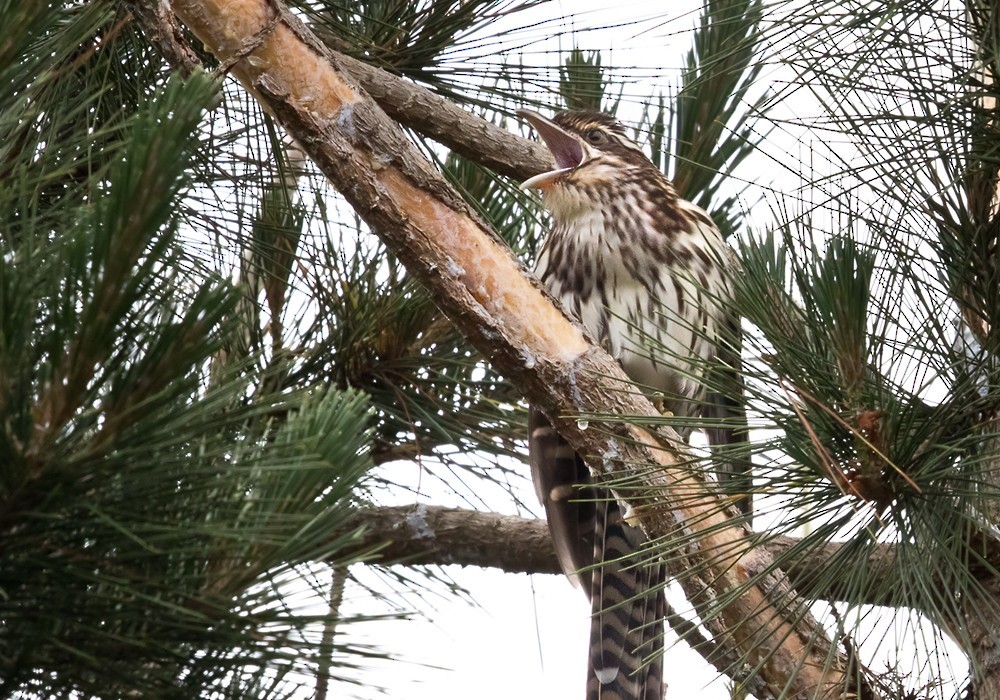Pacific Long-tailed Cuckoo
A species of Pacific Long-tailed Cuckoo, Also known as Long-tailed Cuckoo Scientific name : Urodynamis taitensis Genus : Pacific Long-tailed Cuckoo
Pacific Long-tailed Cuckoo, A species of Pacific Long-tailed Cuckoo
Also known as:
Long-tailed Cuckoo
Botanical name: Urodynamis taitensis
Genus: Pacific Long-tailed Cuckoo
Content
Description General Info
 Photo By Lars Petersson
Photo By Lars Petersson Description
The long-tailed cuckoo has a length of approximately 40–42 cm; wingspan of approximately 47–52 cm and weighs about 120 grams. Large cuckoo with broad pointed wings, very long tail and softly rounded at the tip, and short stout with two coloured bill, both slightly hooked tip. Brown barring to Brown upperparts, and dark streaking to white underparts. Both males and females share similar features. Young cuckoo is very different from adult: it is spotted, and buff underneath and on sides of head and neck. Adult Top of head and hindneck, dark brown, boldly streaked buff. Supercilium, White's, bordered below by bold dark-brown eye stripe continuing downsides of neck, cheeks, chin, throat and foreneck, whites with thin brown stripes and fine black streaking on near neck and throat. The remainder of the upperparts are brown with white spotting on wing. Tail is tipped white. The underbody is white with course black brown streaking. Legs and feet are gray to green. 
Size
23 - 41 cm
Nest Placement
Ground
Feeding Habits
Pacific Long-tailed Cuckoo primarily consume insects, but their diet includes bird eggs, nestlings, and adult birds, as well as lizards. They occasionally savor fruits and seeds. Notably, pacific Long-tailed Cuckoo exhibit kleptoparasitism, feeding on the provisions gathered by host parents for their young.
Habitat
Pacific Long-tailed Cuckoo predominantly inhabits dense forests with a range from lowlands to mountains, featuring closed canopies and diverse tree species. These birds adapt to varied vegetation and are found in native forests, shrub-lined riversides, and even human-altered landscapes such as agricultural fields and suburban areas. Their habitat extends across Pacific islands, including gardens and coconut plantations.
Dite type
Omnivorous
General Info
Feeding Habits
Bird food type
Behavior
Long-tailed cuckoo have many partners during their lifetime. They mate and break-up easily. Males gain attraction from females through spanning their wings and fluttering them whilst calling. Male cuckoo have a high pitched sound and they are very territorial. You will hear them calling either to make known their territory to other birds or as a call for a mate. Female cuckoo are similar in their vocal intensity. Their behaviour is sexual and combative when mating. Male often display their wings or their ability to fly well when looking for a mate. 
Distribution Area
Endemic to New Zealand. In New Zealand they can be found on little barrier island, the West Coast of the South Island of New Zealand, Nelson, and throughout the central North Island. 

 Photo By Lars Petersson
Photo By Lars Petersson Scientific Classification
Phylum
Chordates Class
Birds Order
Cuckoos and Relatives Family
Cuckoos Species
Pacific Long-tailed Cuckoo